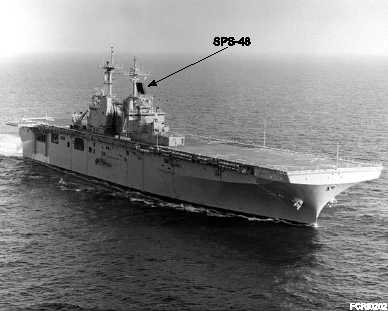c r o s s s e c t i o n a n d a p o t e n t i a l j a m m i n g
environment.
LOW-E (Low Elevation)—Gives priority to the
lower beam groups and transmits them as a
Doppler wave.
The radar can also transmit as a single steerable
beam group or it can burn through jamming using a
chirp pulse.
Radar video, converted to a digital format, is
displayed on consoles to allow operators to perform
manual radar search, detection and tracking functions.
True bearing indications appear when the track
position is displayed in relation to true north, rather
than to ownship.
Variation in frequency tends to make this radar
more resistant to jamming than if it were operated at a
fixed frequency. This provides a solution to the blind
speed problem (“blind speed” is the speed a target
travels that is too fast for the radar to track it) in
s y s t e m s . F r e q u e n cy s c a n n i n g i m p o s e s s o m e
limitations because a large portion of the available
frequency band is used for scanning rather than to
increase the resolution of targets. It also requires that
the receiver bandwidth be extremely wide or that the
receiver be capable of shifting the bandwidth center
with the transmitted frequency.
The radar provides accurate height data by
factoring in the effects of pitch and roll of the ship and
changing the transmitted frequency accordingly. The
ship’s gyro system provides the radar set with this
pitch and roll data.
The AN/SPS-48 radar works with other onboard
radar sensors through the SYS-1/SYS-2, as did the
AN/SPS-52C. Search data from the AN/SPS-48 radar
is sent to multiple weapon systems. These include the
Mk 91 Fire Control System for the SEASPARROW
missile system, the Mk 95 radar, the Mk 23 Target
Acquisition System, the Close-In Weapon System, and
the Rolling Airframe Missile (RAM) System.
The AN/SPS-48 search radar is found onboard
NIMITZ (CVN-68) (figure 2-3), KITTY HAWK
(CV-63), and ENTERPRISE (CVN-65) class carriers,
BLUE RIDGE (LCC) class amphibious command
ships, and WASP (LHD) and TARAWA (LHA) class
amphibious assault ships.
Q1.
What operational characteristic makes the
AN/SPS-48 series radar resistant to jamming?
MISSILE AND GUN FIRE CONTROL
RADAR
Although you may be involved in the operation of
search radar, the majority of your work will be with
radar systems used to control the direction and fire of
gun and missile systems. These radar systems are
normally part of a larger system. They are called Gun
Fire Control Systems (GFCS) or Missile Fire Control
Systems (MFCS). Some systems may be able to
control the fire of either guns or missiles. These are
2-3
Figure 2-2.—SPS-48 series radar on USS Boxer, a WASP class
amphibious assault ship.

